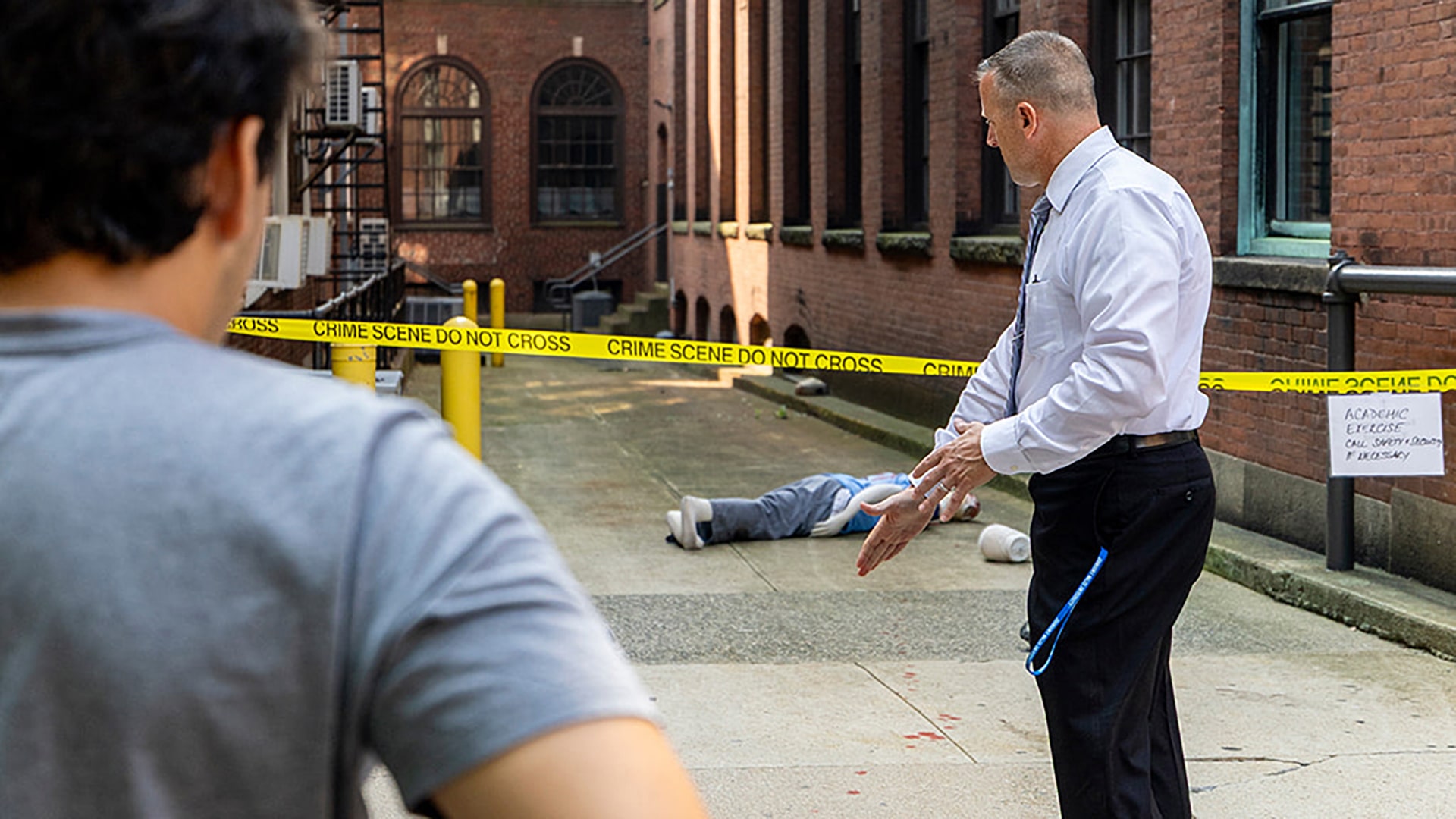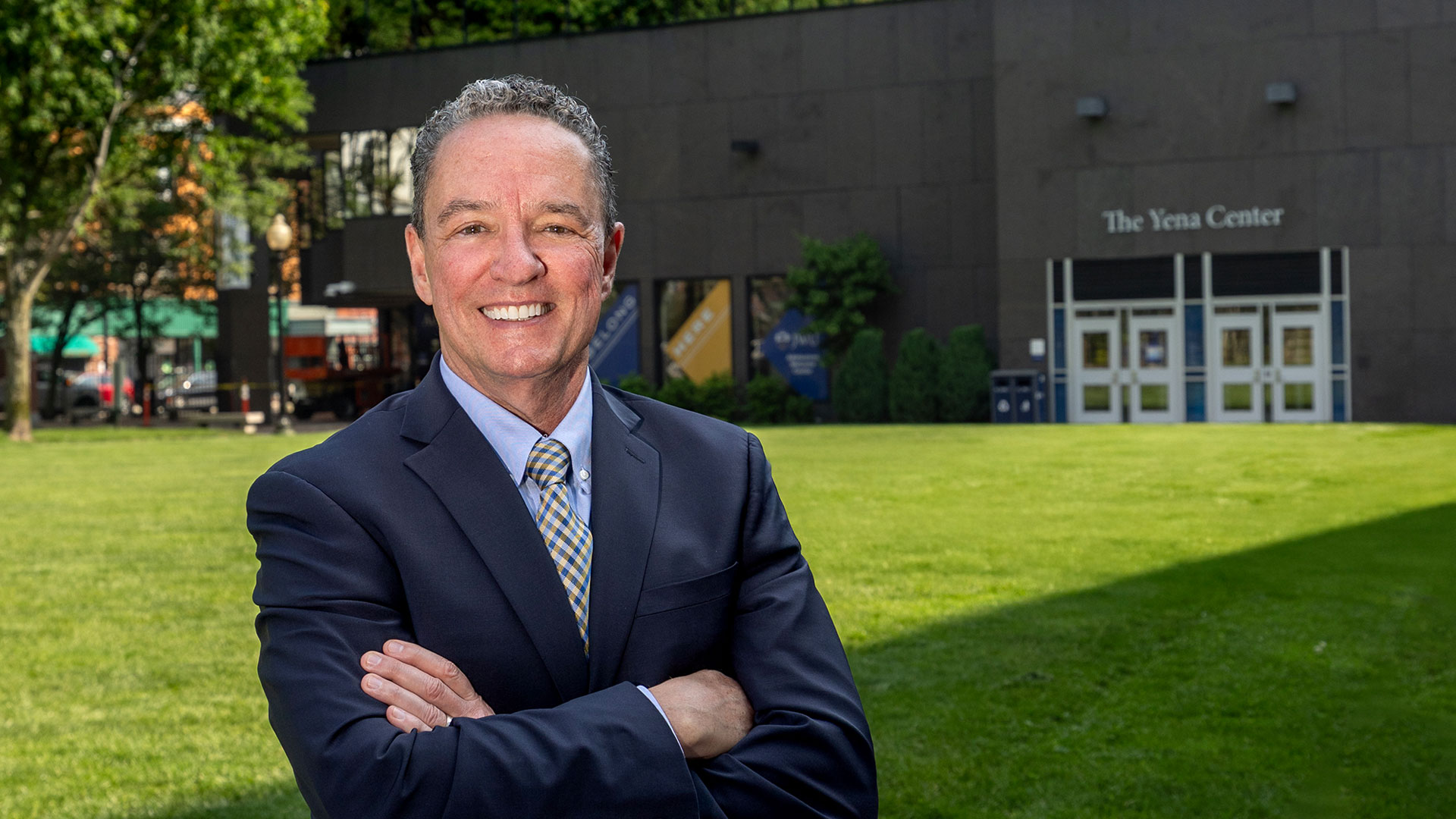State of the Art with Heart
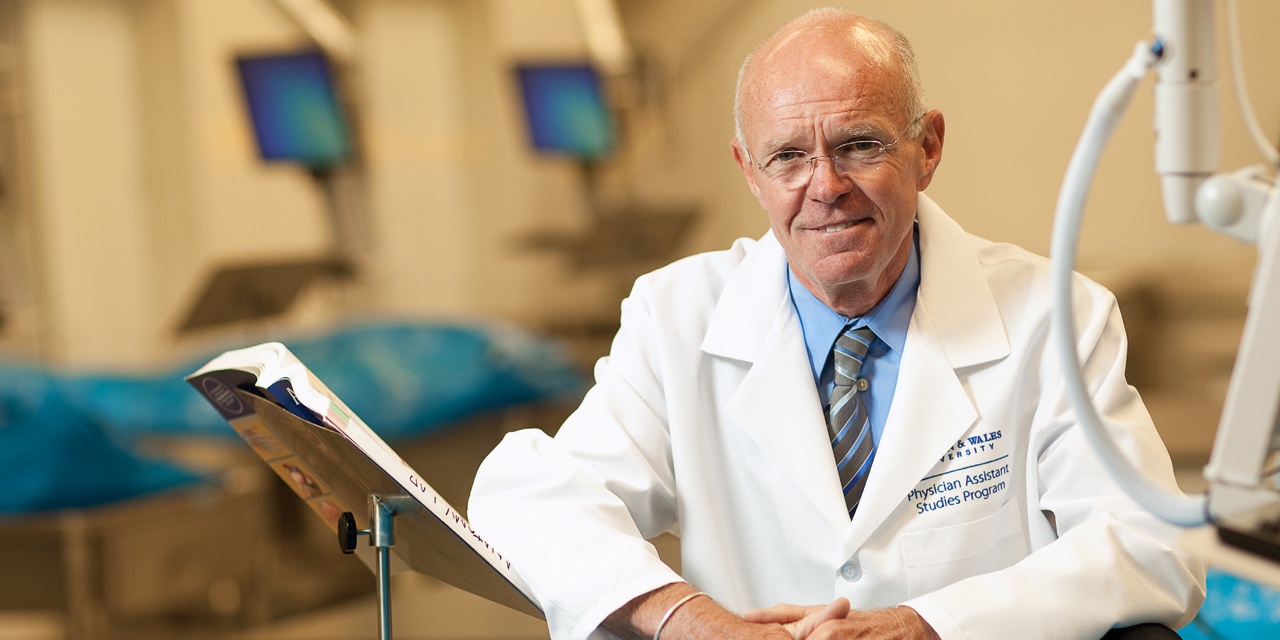
As Johnson & Wales launches Rhode Island’s first physician assistant program, students learn to practice with a healthy dose of compassion.
As we enter the Gross Anatomy Lab, the temperature drops dramatically. Goosebumps form on my arm as I reach for a lab coat and put on two pairs of latex gloves. Turning a corner, 7 surgical tables come into view, each topped with a body-sized blue bag. A computer monitor is mounted over each table, and a camera is fixed to the ceiling in the front of the room.
Laura Coral ’16, the student I am shadowing, explains that the instructor can position her table under the camera to demonstrate surgical techniques in real time. This helps the students, who are grouped four per cadaver during Anatomy Lab, to perform dissections correctly.
A stack of glossy anatomy books sits in the room’s center for students in need of a quick reference. As I flip through one of the books, Coral asks me if I would like to see a cadaver. I tell her yes and we walk to the front of the room to the longest blue bag.
As she unzips the bag, she tells me that their class has been studying neurology, which involves removing the brain to understand its parts and functions. She is gentle and respectful as she identifies different body parts for me. Near the liver, I see an area of flesh covered in small yellow patches. When I ask Coral what these are, she exclaims, “Those are epiploic appendages!” and explains that these are small pockets of fat that line the colon.
Coral’s enthusiasm is so infectious that I forget my apprehension. I stand, staring into a cadaver’s chest at lunchtime, and all I can feel is awe at the human body and curiosity about its systems. Coral meticulously puts everything back in place, covers the body in a soft, ivory flannel wrapping, and together we zip up the bag. We walk to the back of the room where Coral shows me the brain that they have been studying this week, teaching me the function of each part.
We also look at a set of intestines and a gall bladder, which has an emerald center. When I marvel at its green color, Coral fervently nods and tells me that it contains bile, which aids in digestion. When we are finished in the lab, we head to the kitchen for lunch, disposing of our gloves in a biohazard container and washing our hands thoroughly in the sinks that line the front wall.
On our walk over, Coral explains that the anatomy lab was a major factor in choosing Johnson & Wales’ new Physician Assistant (PA) Studies program on its Providence Campus. She tells me that at most other programs, PA students share cadavers with medical schools, often accessing them only after medical students have finished their dissections. This means that PA students get less of the hands-on experience that drew Coral to JWU. “I have always been a very hands-on person and I wanted to get that dissection,” she says. The ability to practice in this lab under the guidance of her professors gives Coral confidence for her future practice.
"We really look for students who have a philanthropy of spirit."
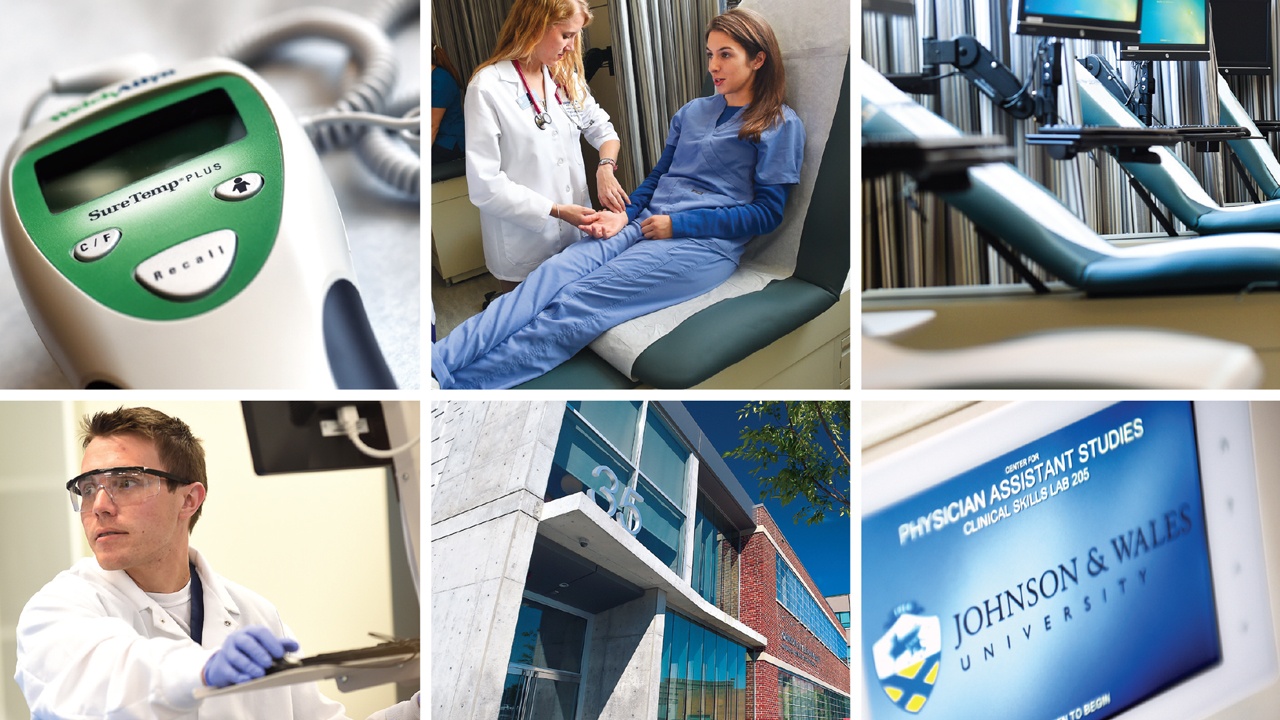
TOP: GEORGE S. BOTTOMLEY, DIRECTOR OF THE CENTER FOR PHYSICIAN ASSISTANT STUDIES AT JWU. ABOVE: CLASSROOM DETAILS, FROM CLINICAL LABS TO THE LATEST EQUIPMENT. ALL PHOTOS: KATHLEEN DOOHER
DEDICATED FACULTY
I met up with Coral after her immunology exam. Throughout the morning, we talked about her childhood in Chelmsford, Mass., and her family, who are Colombian. She became interested in health care when her grandmother, who still lives in Colombia, was diagnosed with Type II diabetes.
A biology major at UMass Lowell, she sought out jobs related to Latino health and diabetes, and landed a position as a research assistant for the Latino Diabetes Initiative at Harvard Medical School’s distinguished Joslin Diabetes Center. Her experiences at Joslin strengthened her interest in a health care career and led her to research PA programs around the country.
The warmth and commitment of JWU faculty impressed Coral just as much as the facilities. Upon visiting the campus, she found that “their passion radiates from them in the first 5 minutes.” Seeing this level of dedication was crucial to her decision to join JWU’s inaugural class. “I just felt their positivity and how many hopes and expectations they had for their first class,” she said. “You could just see that they want us to succeed. They are giving us the best resources that we would need for that. And that just really made me want to be part of it.”
Earlier that morning during Coral’s first class, Professional and Health Policy Issues, I could see exactly what she meant.
Rebecca Scott, PhD, the instructor (and senior academic coordinator for the program), warmly greeted each student by name and handed them a giant sticky note and marker as they entered the classroom. As the students interacted with her, they visibly relaxed, letting go of the residual tension from the exam. She then handed each person a slip of paper with an historical event written on it, such as the Civil War, the Great Society and September 11th. Each student wrote down as many details as possible about their assigned event. Lists complete, they arranged their descriptions on the wall chronologically, and presented to the class. Scott gently and helpfully filled in any missing details.
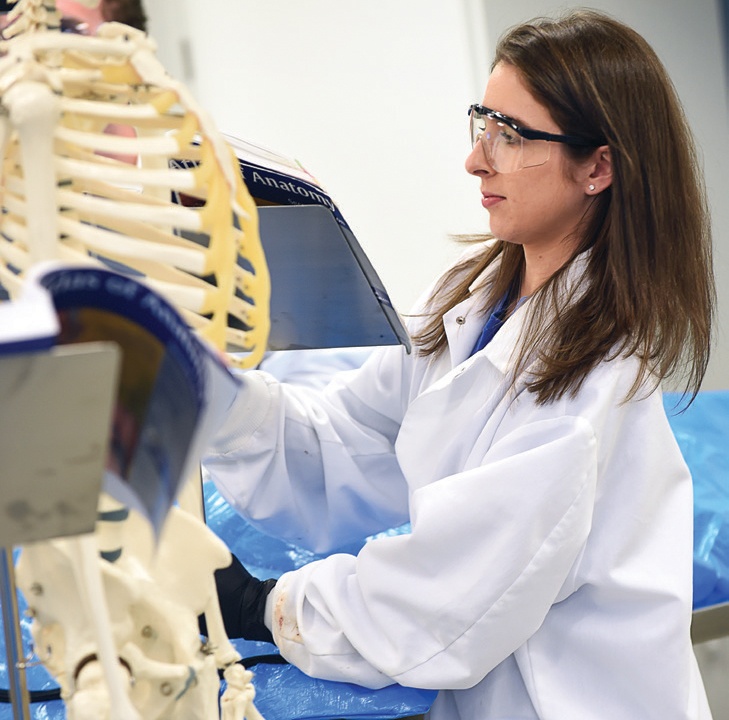
PA STUDENT MONICA SOUZA AT WORK IN THE GROSS ANATOMY LAB. PHOTO: KATHLEEN DOOHER
It was clear from this exercise that the students weren’t afraid to make mistakes or ask questions. This is an attribute the program’s director, Dr. George Bottomley, values: “Rewarding curiosity is a hugely important concept for me and for the faculty that I hired,” he said. “We look for students that have brains and hearts, but also that spirit and curiosity … that can really motivate them to do whatever they want.”
Once all of the students had shared, Scott began a lecture on the evolution of public health policy, directly relating her lecture to their presentations and highlighting how this history enriches their evolving field.
INNOVATORS IN AN EVOLVING INDUSTRY
The sense of history and practice demonstrated in Scott’s class is emphasized throughout the building. A second-floor wall displays a timeline of the physician assistant field.
It begins in 1967 with the first graduating class of PAs from Duke University and ends with JWU’s inaugural class, highlighting their contribution to a burgeoning field.
On the first floor, a series of pictures shows the history of the building and how it was remodeled to house the classrooms and students that fill it today.
Evidence of the neighborhood’s changing face can be found everywhere — in the newly poured sidewalks that surround the building, and in the clusters of trees waiting to be planted in the open lot across the street. Both the inside and outside of the building give the distinct impression that big things are happening here.
Within the walls of the Center for Physician Assistant Studies, exciting things are definitely happening.
Practically speaking, there is no better time to become a PA. In a 2014 list of the best master’s degrees for employment, Forbes ranked PAs number one. Several factors contribute to this demand. For one, over the past decade or so, the United States has faced a shortage of primary care providers. At the same time, the population is rapidly aging and many more people have chronic health conditions such as diabetes or hypertension.
"There’s not a more collaborative practitioner than us around, by definition. We want to be part of a team."
Moreover, the passage of the Affordable Care Act (ACA), which mandates health coverage for all, has increased the number of insured patients seeking primary care. This confluence of factors has both exacerbated the primary care shortage and intensified the demand for approaches to care better suited to chronic disease management and geriatric health.
The ACA attempts to address both of these issues with provisions to increase the number of primary care providers and incentives for innovative and team-based approaches such as patient-centered medical homes. These strategies allow providers to attend to larger numbers of patients because labor can be divided so that supervising physicians can focus on complex health issues while other staff, such as PAs, handle routine visits. Ultimately, team-based approaches result in lower health care costs and greater efficiency.
Because PAs are typically supervised by a physician, they are particularly well-suited to work in teams to provide health care. PAs are given the authority to examine, diagnose and treat patients, and are allowed to prescribe medication in all 50 states. Bottomley says, “There’s not a more collaborative practitioner than us around, just by definition. We don’t want to be autonomous of physicians; we want to be part of a team.” Students like Coral agree.
When she envisions her future, she imagines working with Latino patients and playing a pivotal role in preventing Type II diabetes: “I see myself providing medical care but also providing education and nutritional advice. I see myself taking part in a group effort.”
The center is designed, from floor to ceiling, to help students like Coral achieve their goals. The brand new building, which is located in Providence’s former Jewelry District, is extremely modern and resembles a jewel box with its deep red, rusty orange and bright yellow accents.
The waiting area features a wall of windows from which the sun pours in, kissing the colors and making them pop. The structure is a mix of steel, cement and maple, a comfortable space that holds everything a student might need. On the second floor, a common room with an adjacent kitchen and locker rooms allows students to store scrubs, a change of clothes, books and food. Common spaces are surrounded by group study rooms, computers and printers. A look around reveals that these rooms are well-used; the large wipe boards in each study room display the aftermath of the morning’s exam — carefully drawn anatomical diagrams and other immunology notes written in various handwriting.
Each of the building’s classrooms is state of the art. The patient care classroom, where I ended my day of shadowing, features a long center table surrounded by 12 exam rooms. Each one is equipped with a bed, a yellow stool on wheels, a curtain for privacy, as well as the familiar wall-mounted blood pressure cuff, thermometer, ophthalmoscope and audioscope. During this particular class, Scott demonstrates a standard neurological exam. At the end of her lecture, she excitedly shouts, “Now, we practice!” The students then break into groups of three. One acts as the patient, one as the PA, and the third reviews the procedure list to ensure that no steps are missed.
As they proceed through each step, Scott walks around to observe. Nearly every cluster of students stops her to ask a question. She answers each one, demonstrating procedures and watching her students mimic her actions. Although this is just practice, the students are so intent on getting each component right and communicating what they are doing that they seem to forget that they are interacting with a classmate rather than a patient.
It’s in these moments that the center’s mission of teaching humanistic medicine shines through. Humanistic medicine focuses on creating respectful and compassionate relationships between health care professionals and their patients.
Its core values include integrity, altruism, empathy and service, qualities which are also emphasized in the JWU admissions process. According to Bottomley, “We really look for students who have a philanthropy of spirit … who have a history of giving of themselves to something greater than themselves. We look for volunteerism.”
SOMETHING FOR ALUMNI TO BE PROUD OF
Together, all of the program’s pieces — its humanistic orientation, admissions process, curriculum and even the facility itself — will yield an inaugural class of highly skilled and versatile PAs. Just as the center has transformed the neighborhood, its first graduates will indelibly shape the health care industry.
Bottomley believes that the program is something that Rhode Island and alumni should be proud of: “JWU is continuing to do what it has always done, which is to educate students to be good, important citizens and make a difference. They are certainly doing that with this program. This building is a metaphor for what the university will be doing for the next 100 years.”
VIDEO: CENTER DIRECTOR GEORGE BOTTOMLEY DISCUSSES THE PROGRAM’S UNIQUE ADVANTAGES.
